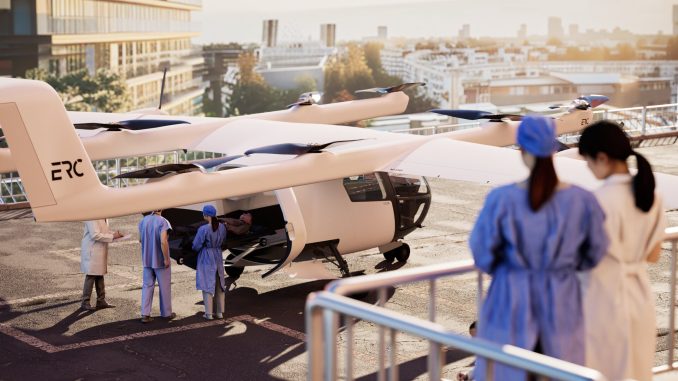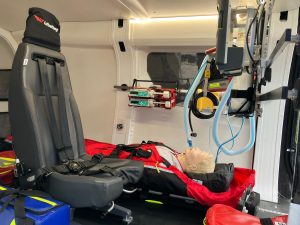
From our special correspondent
ERC has unveiled an eVTOL patient transport/air ambulance designed to carry a patient, medical gear, medical personnel and the pilot. The focus for the concept is on transport between secondary care facilities for patients that cannot be safely moved via a ground-based ambulance and for initial treatment of casualities.
Christopher Schropp, Co-Founder/Chief Engineer, ERC said that with a load capacity of 450 kg and a range of approximately 190 km, the eVTOL is equipped to support inflight medical assistance. The typical distance for this type of flight is 30-40km. The prototype unveiled at the launch did not have the batteries on board. He explained that they will be located under the wings in the final aircraft, which works based on a distributed electric propulsion system. Their current expectation for test flights is late 2024/early 2025, with a market introduction in 2029.
According to ERC market analysis in cooperation with the University of Alabama, there are currently around 82 million acutely ill and injured individuals in Europe and the United States that need urgent medical transport. Helicopters can only support about 1.5 million patients today. A better solution is needed.

Dr David Löbl (CEO, ERC System, GmbH) said: “As hospital density decreases and distances between medical facilities grow, emergency services face increasing challenges. Traditional ambulances often fall short in speed, whereas helicopter flights incur high costs and significant noise. The eVTOLs developed by ERC offer an efficient resolution to these issues, serving as an ideal enhancement to existing helicopter transport capacities. eVTOLs are three times faster than ambulances and three times more cost-effective than helicopters.”
The company is 100% focused on medical transport and has been working with industry experts to develop a solution that is purpose-built to meet the needs of patients, medical personnel in flight and rescue aircraft operators. It has signed letters of intent with GesundheitsregionPlus Unterallgäu-Memmingen and DRF Luftrettung, one of Europe’s premier air rescue organisations. Working closely with DRF during the development process has allowed for the specific needs of the rescue aircraft operators to be incorporated into the design and functionality.
These agreements are part of a pilot project aimed at accelerating the development, certification, and operational testing of the aircraft. Additionally, ERC is collaborating with the Clinic and Polyclinic for Trauma Surgery at the Klinikum rechts der Isar, Technical University of Munich, to optimise the medical capabilities of the eVTOLs.
Prof Dr Peter Biberthaler (Director of the Clinic and Polyclinic for Trauma Surgery, Klinikum rechts der Isar / Technical University of Munich) said: “Time plays a paramount role in the quality of emergency patient care. Even brief delays can determine the life-or-death outcomes for severely injured patients. The significance of this factor is magnified by the increasing number of interhospital transfers driven by the growing specialization of medical technology and the corresponding need for specialized medical personnel. Consequently, we are committed to supporting ERC in developing medical eVTOLs based on the most current medical knowledge.”
The unveiling was also attended by the Bavarian State Minister for Health, Judith Gerlach who said: “Especially in rural areas, the quick and efficient transport of patients and the injured is crucial. Innovative air rescue systems could complement the existing ambulance and rescue helicopter services in the future.” ERC views its eVTOL ambulance concept as a complimentary one, not a competitive one, as there are situations and locations that will lend themselves better to an eVTOL aircraft od a helicopter.
According to Bill Wemberly, Chief Revenue Officer at the company, when you consider emergency transport, from outside of the industry, the first image that comes to mind is an air ambulance at the scene of an accident or a critically ill call for help from someone who doesn’t have the time to wait for an ambulance. The reality is that more than 50% of the air-based transport in this market is non-emergency/non-crisis transport between two medical facilities. This is the first priority market for ERC.
The company’s marketing highlights saving time and cost. From the aircraft operator’s perspective, the first area of cost reduction is from the purchase of the aircraft itself. A typical helicopter air ambulance costs between EUR9-15 million. ERC’s aircraft is expected to be about one-third of the upper end of this range. Of course, the ranges are impacted by the required functionality onboard.
The second area of cost savings is time. An eVTOL can take off much faster than a helicopter and is less complex from a maintenance perspective, with eight motors and wires as the main technical components. One of the cost drivers of air ambulance helicopters is their downtime. On average per year, they spend the equivalent of one out of twelve months offline for maintenance.
From the perspective of the patient, the impact is more about the experience and level of medical care. eVTOLs are much less noisy. ERC has a rear entry door to bring a patient on board without having to manage a potentially difficult entry on a gurney and more room for the medical personnel to do their job while in flight.
Hospitals are key in the business development discussion as they will be potentially recommending this solution to the air ambulance operators. ERC is already in talks with operators and hospitals in Italy and the USA.


